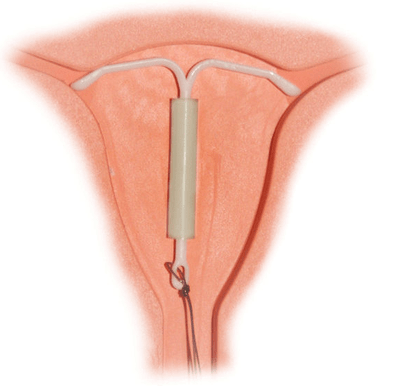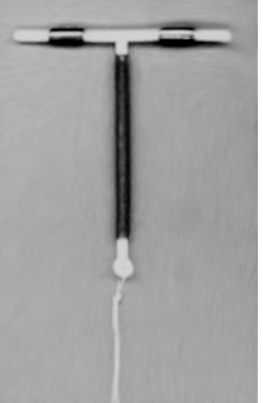Advertisement
Why The IUD Is On The Rise (And You Might Want One)
http://www.youtube.com/watch?v=-2oMElDcpdM
(Above: A 7-minute IUD show-and-tell by a leading expert, Dr. Eve Espey)
Full disclosure: I had an intra-uterine device implanted soon after my second child was born, and in my own experience, using an IUD for birth control is something like what Churchill said about democracy: It’s the worst system around — except for all the other ones.
My first few months with a Mirena — an IUD that emits tiny levels of the hormone levonorgestrel — were rife with unpredictable spotting. That certainly got very old very fast. But then the spotting ended, and my periods blessedly all but disappeared, a common Mirena effect. It's been nearly seven years now, and I've been both problem- and pregnancy-free. I even re-upped for a second device when the first one hit its five-year limit.
So that's my bias when I report that in recent weeks, I’ve noted a striking convergence of signs pointing to a new era of far greater popularity for IUDs. There’s even talk of an IUD “renaissance” — once all but unthinkable after the debacle of a 1970s device called the Dalkon Shield.

In the not-too-distant future, getting an IUD, which costs several hundred dollars, will be universally covered and co-pay-free under new federal insurance rules. The latest numbers suggest IUD use among American women has risen dramatically in the last decade. And the IUD's safety record is looking so good that recent research finds that the devices can even be implanted right after an abortion or a birth.
“The message is finally getting out there that IUDs are a great option — that they’re highly effective, that they’re long-acting, and they provide reversible, highly effective contraception with just one act,” said Dr. Alisa Goldberg, director of clinical research and training at the Planned Parenthood League of Massachusetts. (That "one act" is having the IUD implanted, a quick office procedure.)
[module align="right" width="half" type="pull-quote"]
Among the first 2500 women who enrolled in the study, 56% --- that’s right, more than half — chose to get IUDs.
Advertisement
[/module]
“And the message is finally getting out there that the old days — the days of the Dalkon Shield — are long behind us,” Alisa, who's also director of the division of family planning at Brigham and Women’s Hospital, said. “There are increasing amounts of data showing the safety, the efficacy and the increasing popularity of these methods.”
In a country where nearly half of pregnancies are accidental, “This could have a huge impact on public health,” she said.
No, she’s not in the pay of the IUD makers. She sounds just like many other evidence-based experts on contraception who have been pushing for greater IUD use for years. In fact, it was because I’d read some of their research that I opted for an IUD seven years ago, despite a lingering sense of past disaster.
Now the factors in the IUD's favor are visibly multiplying. Most recently, new federal rules announced earlier this week, requiring insurers to cover women’s contraception without co-pays, will remove the upfront costs that put many women off IUDs.
"Cost-effective birth control'
The rules apply to all FDA-approved birth control, and the Institute of Medicine report they were based on even points out that the most cost-effective birth control methods are “long-acting contraceptives that do not rely on user compliance” — like IUDs. It's that faulty "user compliance" -- the missed pills, the skipped condoms -- that leads to so many unwanted pregnancies.
The new rules won’t take effect broadly until 2013, but when they do, expect a bump in IUD use among all the women whose insurance gaps or high deductibles were holding them back.
"Safe for use by almost all"
Now let's go back a couple of months. The American College of Obstetricians and Gynecologists, a leading women’s health authority, issued a press release that began:
“Long-acting reversible contraceptive (LARC) methods—namely intrauterine devices (IUDs) and implants—are the most effective forms of reversible contraception available and are safe for use by almost all reproductive-age women, according to a Practice Bulletin released today by The American College of Obstetricians and Gynecologists.”
For years, the medical wisdom had been that because IUDs could cause infections that pose some fertility danger, they should be used only in women who have already had children.
The college’s new guidelines marked yet another official move away from that idea. Already, it had accepted a committee’s recommendation that IUDs and implants be offered as “first-line contraceptive methods and encouraged as options for most women.” (Implants are matchstick-sized, hormone-emitting rods implanted just under the skin.)
Dramatic rise
Those professional opinions appear to be making inroads. IUD and implant usage among American women on birth control, long moldering at around 1% in the '80s and '90s, has been rising dramatically. It went from 2.4% in 2002 to 5.6% by 2008, according to a paper published this June in the journal “Obstetrics and Gynecology.”
How high could that rising number go? Maybe pretty high. IUD rates in Europe range from 9% to 15% of women using birth control.
Maybe even higher: A recent experiment in Saint Louis called “Project Contraceptive CHOICE” set out to educate women about all methods of birth control, including IUDs and implants, and to remove cost barriers by giving them their chosen methods for free.
As described last year in the American Journal of Obstetrics and Gynecology, among the first 2500 women who enrolled in the study, 56% --- that’s right, more than half — chose to get IUDs. Another 11% chose implants.
Downsides and side effects
I confess, I have some concerns about writing an ode to the IUD. Because the devices can cause complications and side effects. And the saga of the defective Dalkon Shield was a truly frightening one.
The Dalkon Shield was a 1970s IUD that had a fatal flaw: a tendency to “wick” bacteria from the vagina into the normally sterile uterus, causing serious pelvic infections that could lead to miscarriages, infertility, ectopic pregnancies — even death. (Modern IUDs avoid this design flaw.) Tens of thousands of women testified that they had been injured, and after many years of legal battles, received damages.
So I checked with Judy Norsigian. She is executive director of the revered women’s health bible Our Bodies Ourselves. (Bulletin: a new edition is due out in October. Please stay tuned.) I trust her opinions on birth control; she was even deposed during the Dalkon Shield class action lawsuit in the 1980s.
She referred me to the Our Bodies Ourselves Website, which included a link to this excellent fact sheet about IUDs, listing pro’s and cons.
The upcoming Our Bodies Ourselves will include updated IUD information, she said, “but we’ve already been taking the position, because of the most recent research we have, that it’s a method that works very well for lots of women.”
“Like every method,” she said, “it has its downsides. There’s a remote risk of embedding and perforation, but it’s small. And some women have a lot of pain, others don’t. Some women expel the IUD, others don’t. But for most women who have very heavy periods, using the [Mirena] IUD results in lighter periods and decreased bleeding at menopause. So there are benefits as well. It’s one of those things where a woman has to weigh her own priorities about what matters most to her.”
The copper option
I wondered what that thinking sounded like these days, so I approached a highly with-it twentysomething woman I know and asked if I could talk to her about IUDs.
“I want one,” she said instantly.
She had trouble recently with birth control pills, she said, and was seriously considering getting a ParaGard, a copper IUD that emits no hormones. Her close friend had gotten an IUD about a year ago, and her colleague was considering one as well. Her mother was for it, and so was the Planned Parenthood center where she gets her birth control.

The hormone-emitting Mirena gets much of the attention, with TV ads and other splashy marketing, but the copper, no-hormone ParaGard — the other main IUD available — has its fan base as well. It sometimes gets short shrift, Dr. Alisa Goldberg said, but it shouldn’t.
'What does the science say?'
The recent rise in IUD popularity can be seen across the board in American women of childbearing age, the June paper in the journal Obstetrics and Gynecology found. But the biggest increases are among “the youngest and oldest age groups, non-Hispanic white and non-Hispanic African American women, foreign-born women and those in the highest income group.”
“There are no perfect contraceptive methods," said Lawrence Finer, the paper’s co-author and director of domestic research at the Guttmacher Institute, a non-profit that studies sexual and reproductive health. But the IUD “is certainly an under-utilized method.”
“I think there’s some real potential here to make progress on unintended pregnancy,” he said. “For women who are currently considering an IUD, I would just encourage people to focus on: What does the science say? And what have the major reproductive health medical organizations recommended? And based on those recommendations, women who are trying to decide on a contraceptive method should consider the IUD as a prime candidate.”
This program aired on August 5, 2011. The audio for this program is not available.
